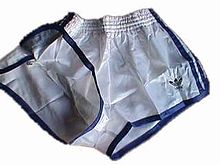Exemption (picture)
In photography , in prepress and in computer graphics, exemption means the liberation of a subject from a disturbing background; The mask for cropping an image is usually called a cropping in technical language . In the printed matter , too , a “free-standing object” without any text reference on the same page is referred to as a “cut out”. This is often referred to in the following text.
Areas of application
Clipping can be necessary for a variety of reasons. The most important are:
- It should be ensured that the viewer is not distracted by the background and other accessories; sometimes the partial clipping takes place. In this case, unimportant areas of the image are not made to disappear entirely, but only weakened ( contrast reduction while increasing the brightness, similar to high-key photography ) in order to preserve the context of the subject and at the same time draw the recipient 's attention.
- One would like to create starting material for photo montages , so the motif should be able to be inserted into any other picture context, one reason why cutouts play a dominant role in advertising .
See also: picture agency , advertising photography , product photography .
Techniques in recording
There are several techniques of clipping. The first is to use a mostly pure white and shadow-free illuminated background when taking the picture. In the dark-field recording, on the other hand, the motif is positioned on a glass plate that is just as reflective-free and is placed on a matt black lined or lacquered box, tub or similar. This creates the impression that the motif is “floating” in front of a distant black background (similar to a star in space).
Traditional techniques (analog photography)
In the case of photos that you would like to cut out afterwards, common techniques of retouching then required in a conventional photo laboratory are u. a.
- the masking (also sometimes occurs during recording are used, each knows the keyhole or binoculars -Pictures from films that are intended to indicate that a player has just this view)
- the dodging
- the weakening of undesired or overly superficial parts with appropriate chemicals (see Farmer's attenuator )
- the cut-out mask is cut manually from a masking film on the light table after the photograph or drawn with red chalk.
The simplest method is the one that predominates in the editing assembly: the motif is carefully cut out, mounted (glued) on a pure white background and photographed again (see repro photography ). When photographing larger objects, the object is positioned in front of a hollow , also to avoid disturbing spatial lines.
Electronic image processing
In electronic image processing , various tools are used for masking, which is used to select parts of the image to be deleted. The most important of these are:
- the magic wand and the chroma / color mask for automatic masking (the same color areas are masked within a selectable tolerance threshold). However, this automatic process is relatively imprecise, especially when taking pictures with backlight against a white background, the object is often unintentionally masked.
- Lasso for hands-free masking (in some programs decidedly Freehand mask called)
- the masking by means of assigned shapes (circle, square or ellipse and rectangle)
- the path (created with the pen tool). Similar to the lasso, but every shape can be traced exactly. For example, to trace a circle, in contrast to a lasso, fewer points are necessary. While only straight lines can be set with the lasso or the lasso automatically clings to an object, which ultimately leads to an angular or imprecise masking, paths can trace every contour precisely, as the individual routes can be rounded off. As in Adobe Illustrator , the pen tool works on the principle of the Bézier curve . The big advantage of the set path is that it can be selected and corrected again and again afterwards. The path is retained even after saving in JPG, TIFF and PSD format.
Then the masked areas of the image are replaced with the desired uniform color (usually white or black) with the filling tool, or the background is removed.
Other meanings
By cropping a picture design technique is used in photography often that is less by selective use of field depth of an object stand out from a blurred background. For this purpose, bright lenses and longer focal lengths are usually used.
See also
- Tabletop photography
- Blue screen technology (blue box for television)
Individual evidence
- ↑ Archived copy ( Memento of the original from September 27, 2013 in the Internet Archive ) Info: The archive link was inserted automatically and has not yet been checked. Please check the original and archive link according to the instructions and then remove this notice.



